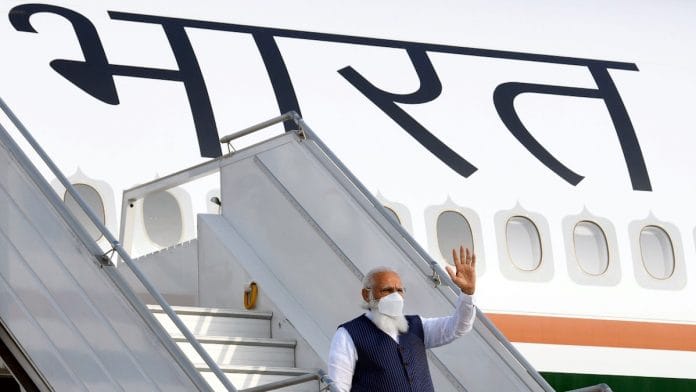When Prime Minister Narendra Modi meets Chinese President Xi Jinping later this week in the ancient Silk Road town of Samarkand in Uzbekistan, it will be an opportunity to celebrate the hard-nosed diplomacy played by Delhi, which linked the meeting with the Chinese withdrawal from its positions along the Line of Actual Control (LAC) in eastern Ladakh.
Modi’s presence at the Shanghai Cooperation Organisation (SCO) summit on 15-16 September, where he will also meet Russian President Vladimir Putin and Pakistan Prime Minister Shehbaz Sharif, is leading to increasing speculation about a new tilt in India’s foreign policy.
Modi’s warm remarks at the Eastern Economic Forum in Vladivostok last week, where both Putin and the Chairman of the Chinese National People’s Congress, Li Zhanshu, were listening in, is in marked contrast to the unhappiness in the Joe Biden administration as it watches India’s purchases of discounted oil from Russia grow every day.
Nor does it seem likely that India will abide by the oil price cap that G-7 nations, led by the US, are planning to impose on Russia to punish it for the Ukraine war. As for reports that India and Russia are continuing to work towards a rupee-rouble barter trade mechanism – Washington DC is hardly ecstatic about the news.
Petroleum minister Hardeep Singh Puri recently told CNBC, he felt “no moral obligation” to sign up for the G-7 initiative on the Russia oil price cap.
In this new topsy-turvy world, the fact that Chinese troops are moving to their own side of the LAC, after two long years, is testament to India’s determined refusal to play the Chinese game. PM Modi refused to go to the BRICS meeting in Beijing earlier this summer, although he travelled to Tokyo to participate in the US-led Quad summit.
Indian officials call this decision to walk the middle path, “strategic autonomy,” and it’s not always easy. On the one hand, there is the fact of India and the US being “natural allies,” a phrase as old as Atal Bihari Vajpayee, and on the other, there are repeated Indian abstentions at the UN Security Council on the Russian invasion of Ukraine.
Also read: China lowered the gun for Modi-Xi Uzbekistan meet. India can’t take its eyes off the barrel yet
Modi’s trump card
When Indian officials noted that the SCO summit at Samarkand was nearing – India will host the SCO summit next year, as well as that of the G-20 – they politely linked a potential meeting between Modi and Xi at the summit to a withdrawal of Chinese troops from LAC.
Modi would not attend, Indian officials told the Chinese, if People’s Liberation Army (PLA) troops remained in the positions they occupied along the LAC in April 2020. The message was clear to Beijing.
So on 8 September, one week before the SCO meeting, Chinese troops began to “disengage in a in a coordinated and planned way.” The pullback of the troops, officials told ThePrint, from the Hot Springs-Gogra area, also called Patrolling Point 15, was by “over one kilometre.”
This is not the first time, though, that Indian officials have used this particular charm to get what they have wanted. In September 2017, when Indian and Chinese troops were deadlocked, eyeball to eyeball, on the Doklam plateau in Bhutan, New Delhi let Beijing know that Prime Minister Modi would not go to Xiamen in China, the site of the BRICS summit meeting, if Chinese troops did not return to status quo ante.
The Chinese blinked and Modi caught the flight to Xiamen. There was no way Xi would have done anything to compromise on the pomp and show of his own party – for Modi to be absent in a Chinese city would have been a harsh snub. Both Modi and Xi knew that.
Also read: India-China complete disengagement at Hot Springs but stalemate continues in Depsang & Demchok
Meeting Xi on equal terms
The manouevre at Samarkand is similar, but even more engaging. At China’s post-Covid coming out party, all of Xi’s friends, led by Putin, will be there. For Modi to be absent again – as the standoff on the LAC continued into the second year – would have been a diplomatic slap on Xi Jinping’s face.
Remember, the Chinese leader will return from Samarkand and fall five feet deep into the politics of the National People’s Congress next month, where he is expecting to be nominated for an unprecedented third time and made Dear Leader for life. Under the circumstances, for the leader of a fellow Asian power not to attend the SCO would have amounted to more than a wrinkle in his imagined world leadership plans – especially because everyone in the world would have known why.
For Modi, this is certainly a diplomatic win. He refused to entertain Chinese foreign minister Wang Yi who, unsolicited, flew into Delhi in March, to invite Modi to BRICS – the Chinese Communist Party mouthpiece, Global Times, pointedly remarked that “China and India should not let the border issue define or affect the overall development of the relationship.”
But Modi refused to budge. He would meet Xi only on equal terms. Xi fell in line.
Perhaps another thought crossed the Chinese President’s mind when he did so. By having Modi and Putin and Turkish president Recep Tayyip Erdogan attend the SCO summit, he was perhaps thinking of the several photo-ops that would be splashed across global media. Putin and Erdogan were already in his camp, but what about the Indian prime minister? What would the Western world think of him?
The author is a consulting editor. She tweets @jomalhotra. Views are personal.



